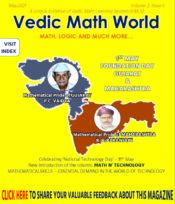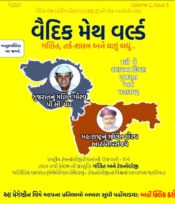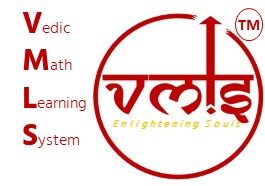Respect Your Roots
Indian scriptures, Festivals & Personalities
(May2021)
MAHAVIRACHARYA - THE FIRST JAIN MATHEMATICIAN
Published in May2021 issue of ‘VEDIC MATH WORLD’ – magazine












MAHAVIRACHARYA – THE FIRST JAIN MATHEMATICIAN
Published in May2021 issue of ‘VEDIC MATH WORLD’ – magazine
INTRODUCTION:
Mahaviracharya was born in 9th-century near today’s Mysore, in southern India. He was born in the year 815 AD. He was one of the earliest mathematicians in India. He is best known as the first Jain mathematician in India who contributed significantly to the field of mathematics. It is assumed that he possibly took his name to honour the great Jainism reformer Mahavira.
Mahavira was a member of the school of mathematics. He worked as a teacher. He taught many people mathematics. Hence, he is also known as ‘Mahavirachrya’ meaning, ‘Mahavira – the teacher’.
He used to work with king Amoghavarsha in the Rashtrakuta dynasty. He applied his mathematical skills to do something good for society. He was the first one to separate Astrology from Mathematics. Before the era of 800 AD, Maths and Astrology were considered as a single thing. Mahavira Knew about Astrology. later on, he studied both astrology and mathematics and separated both into two different subjects.
MAJOR WORKS OF MAHAVIRACHARYA:
- Combinatorics
- Number theory
- Logic
- Calculus and analysis
- Geometry and topology
- Dynamical systems and differential equations
WHY WE ARE TALKING ABOUT MAHAVIRACHARYA IN THIS ISSUE OF VEDIC MATH WORLD?
We are celebrating Mahavir Jayanti on 25th April. To pay our tribute to the Mathematical achievements initiated by Jainism during medieval India, we have included this article on the very first Jain Mathematician – MAHAVIRACHARYA. It is believed that ‘MAHAVIRACHARYA’ took name to honour the great Jainism reformer ‘Mahavira’.
WHO WAS MAHAVIR?
MAHAVIR was the reformer of Jainism. Lord Mahavir was born in 599 B.C. (6th century BCE), at Kshatriyakund, Bihar, on the 13th day of the rising moon of Chaitra month. This day comes in the month of April as per the English calendar. His birthday is celebrated as Mahavir Jayanti day. Lord Mahavira was the 24th and the last Tirthankara of Jainism. The 23rd Tirthankara Parshvanatha’s spiritual inheritor was Lord Mahavir. Mahavira is also known as Vardhamana. His mother’s name was Trishala and his father’s name was Siddhartha.
Mahavira taught that observance of the vows of
Ahimsa (non-violence),
Satya (truth),
Asteya (non-stealing),
Brahmacharya (chastity), and
Aparigraha (non-attachment) is necessary for spiritual liberation.
WHY MAHAVIR JAYANTI IS CELEBRATED?
Mahavir Jayanti is an important religious festival for Jainism. The day is celebrated across the world by the Jain community in memory of the last spiritual teacher of Jainism. As per the Gregorian calendar, it takes place in March or April. As per the Hindu calendar, it marks on the 13th day of the Chaitra month. This year in 2021, it will be held on April 25. On this prosperous festival, a procession is carried out with the idol of Lord Mahavira called the Rath Yatra. Admirers also visit temples, worship Lord Mahavir read religious rhymes, look for his blessings for a healthy and prosperous life, and include themself in the number of charity work in order to give back to society, help society and to do good for other.
ARE MAHAVIR AND MAHAVIRACHARYA THE SAME?
The answer is ‘NO’. They both are not same.
Mahavira: Mahavira was a divine successor of 23rd Tirthankara Parshvanatha. As per the Jain philosophy, all Jain Tirthankaras were inborn as on earth as human beings but they have attained a state of perfection or enlightenment via meditation and self-realization. They are the Gods of Jains.
Mahaviracharya: Mahavira who is also known as Mahavirachrya was a Jain mathematician who born in the year 815 AD . he perhaps took the name Mahavira to honour the great Jainism reformer Mahavira who is born in 599–527 BCE.
MAJOR MATHEMATICAL WORKS ACCOMPLISHED BY MAHAVIRACHARYA
Mahavira has made some great contributions to Mathematics. A few of his contributions are:
- Mahavira in his ‘Ganit-sara-sangraha’ has identified the formula for combination: in Mathematics, Combination (nCr) is a selection of items from a collection. The formula is as follows: nCr = n(n–1)(n–2)….(n–r+1) ⁄ r(r–1)(r–2) ……2·1
- He worked on the same subjects on which Aryabhata and Brahmagupta worked, and he developed the subject.
- Mahavira discovered algebraic identities: identity is an equality type mathematical expression containing some variables, satisfied for any value of the variables.
- He originated the terms equilateral and isosceles triangle, rhombus, circle, and semicircle.
- According to him that it is not possible to have a square root for a negative integer.
- He also come up with a formula that calculated the area and perimeters of ellipses.
- He found technique to calculate the square of a number and cube roots of a number.
- He found the algebraic identities like a3 = a (a + b) (a − b) + b2 (a − b) + b3.
- He found the formula for nCr as [n (n − 1) (n − 2) … (n − r + 1)] / [r (r − 1) (r − 2) … 2 * 1].
- Mahavira also established equations for the sides and diagonals of a cyclic quadrilateral.
- He also established equations for the diagonals and sides of a cyclic quadrilateral.
IMPORTANT BOOK WRITTEN BY HIM AND ITS CONTENT
He Authored the earliest Indian text Ganita sar sangrah (dated 850 CE) devoted entirely to mathematics. He wrote this book in 850 CE. In this book, he mentioned many important concepts of mathematics. ‘Ganita Sara Sangraha’ contains nine chapters and about 1100 slokas. The concepts covered in GANITA SAR SANGRAH are, Sangyaādhikāra (Terminology), Parikarmavyāvhār (Arithmetical operations), Kālaswarnavyavhār (Fractions), Prakīrñakvyavhār (Miscellaneous problems), Trairāshik (Rule of three), Miśravyavhār (Mixed problems), Kśetragaṇit vyavhār (Measurement of Areas), Khātvyavhār (calculations regarding excavations), Chāyāvyavhār (Calculations relating to shadows).
THE QUALITY OF MATHEMATICIAN DESCRIBE IN ‘GANITA SAR SANGRAH’
At the end of this article, we are sharing eight qualities of a good mathematician as per ‘Ganita sar sangrah’:
Gaṇitasārasan̄graha‘s sangyaādhikāra:
लघुकरणोहापोहानालस्यग्रहणधारणोपायैः।
व्यक्तिकरांकविशिष्टैर् गणकोऽष्टाभिर् गुणैर् ज्ञेय॥
“eight qualities by which a mathematician is to be known: conciseness, inference, confutation, vigour in work and progress, comprehension, concentration of mind and by the ability of finding solutions and uncovering quantities by investigation”
